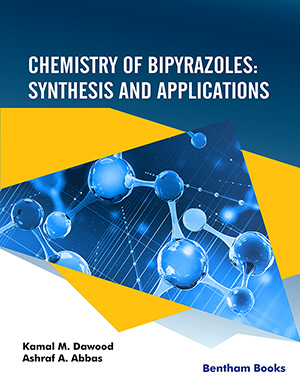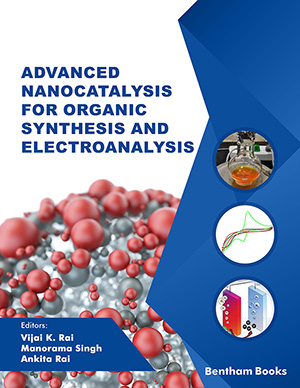
Abstract
Background: Epoxides are widely useful in various fields such as pharmaceuticals, pesticides, cosmetics, polymer synthesis, fragrance compounds, and food additives. However, the synthesis of epoxides involves heavy metal catalysts and toxic, unstable organic catalysts which causes serious environmental and safety concerns. In recent years, biocatalysts have received a great deal of interest in the synthesis of olefin-derived epoxides due to their mild reaction conditions, environmental friendliness, good selectivity, and sustainability. This study focuses on catalases as a biocatalyst for potential epoxidation reactions of olefins.
Objective: To determine the possibility of using biocatalyst catalase from a novel source Sechium edule (squash) for epoxidation of olefins in the presence of H2O22.
Methods: UV-Vis spectrophotometer was used to monitor the formation of epoxide from substrates- cyclohexene, cinnamic acid, cinnamaldehyde, furfural in acetonitrile solvent and a suitable aliquot of the enzyme solution in the presence of H2O22. The products formed were analyzed using FTIR and GC-MS. For the immobilized enzyme, chitosan beads activated with TPP were used in place of the enzyme and a similar procedure was followed for the analysis.
Results: Four different olefin substrates (cyclohexene, cinnamic acid, cinnamaldehyde, and furfural) were selected to study the catalysis reaction of epoxidation by the catalase enzyme. The course of the epoxidation was monitored by UV-Vis, FTIR, and GC-MS methods. However, under optimized reaction conditions and spectral analysis, further confirmed by GC-MS, data showed only epoxide formation from cyclohexene. CAT completely catalyzed other olefins like furfural, cinnamic acid, and cinnamaldehyde into its degraded products biochemically. Therefore, cyclohexene was selected for further immobilization studies and the identified metabolites of olefins and their degradation mechanism. Major biodegradation products of cinnamic acid were found to be styrene( m/z 104.0) and benzaldehyde(m/z 105.0). GC-MS data of biotransformation of cinnamaldehyde, identified 2,4 dimethyl benzaldehyde(m/z 133) as the main product. The catalytic biotransformation of furfural investigated by GC-MS data identified 2,5 dimethyl benzaldehyde (m/z 133), dodecanol (m/z 181) and Pentanoic acid, 5 hydroxy, 2,4 dibutyl phenyl ester(m/z 306) as the major product. Three major oxidized products were detected in GC-MS data from the epoxidation of cyclohexene viz., cyclohexane diol(m/z 116), cyclohexene epoxide-1-ol(m/z 110), cyclohexene epoxide-1-one(m/z 110).
Conclusion: In this investigation, catalase purified from Sechium edule(squash) was developed as an efficient catalytic tool for the biotransformation of olefins and selective epoxidation of cyclohexene. Under optimized conditions, the experimental results revealed the main products found in cinnamaldehyde as benzaldehyde (m/z 133.0) and cinnamic acid as benzaldehyde (m/z 133), styrene (m/z 104.0) and benzoic acid (m/z 122.0), while the data from furfural oxidation could not be justified from previous studies. The optimal concentration of CH3CN solvent for cyclohexene epoxidation was found to be 4 mM. Enzymatic characterization of free and immobilized catalase on chitosan was investigated using cyclohexene as a variable substrate and found to be 0.017 mM, 83.33 μmol/min for Km and Vmax values, pH 6.8 and 30˚C for free CAT and 0.03 mM, 200 μmol/min, pH 7.6 and 35˚C for immobilized one. Immobilization increases the thermal stability of the CAT and changes the pH to alkalinity. The possible oxidation of cyclohexene was deduced as the radical chain mechanism for the generation of epoxide with the key products obtained as cyclohexane diol(m/z 116), cyclohexene epoxide-1-ol(m/z 110) and cyclohexene epoxide-1-one(m/z 110). The reusability of the biocatalytic tool opens up the opportunity to reduce the cost of various catalytic reactions. Further studies can focus on the separation and advancement of epoxide yields, improved immobilization strategy for maximum repetitive cycles, and chemo-enzymatic epoxidation on biological olefins.
Keywords: Epoxidation, biotransformation, immobilization, biocatalyst, catalase, cyclohexene.
[http://dx.doi.org/10.1155/2014/756418]
[http://dx.doi.org/10.3390/catal10070781]
[http://dx.doi.org/10.1002/anie.201800343] [PMID: 29573076]
[http://dx.doi.org/10.1002/9780470134955]
[http://dx.doi.org/10.1016/j.enzmictec.2020.109512] [PMID: 32331717]
[http://dx.doi.org/10.1081/SCC-200066705]
[http://dx.doi.org/10.1007/s10529-008-9791-5] [PMID: 18612597]
[http://dx.doi.org/10.1002/chem.200500584] [PMID: 16240317]
[http://dx.doi.org/10.1021/acscatal.0c05588] [PMID: 33763289]
[http://dx.doi.org/10.1155/2012/626909]
[http://dx.doi.org/10.1051/ocl.2008.0191]
[http://dx.doi.org/10.1039/b913077b]
[http://dx.doi.org/10.1016/0006-291X(86)90507-3] [PMID: 3010998]
[http://dx.doi.org/10.1007/3-540-69791-8_4]
[http://dx.doi.org/10.1002/cctc.201901142] [PMID: 31762830]
[http://dx.doi.org/10.1016/j.enzmictec.2013.02.013] [PMID: 23608506]
[http://dx.doi.org/10.1002/kin.21468]
[http://dx.doi.org/10.1007/s11745-017-4271-0] [PMID: 28631071]
[http://dx.doi.org/10.1074/jbc.M109.013151] [PMID: 19531485]
[http://dx.doi.org/10.1194/jlr.M900025-JLR200] [PMID: 19244216]
[http://dx.doi.org/10.1021/ja070358w] [PMID: 17552520]
[http://dx.doi.org/10.1080/00958972.2018.1469750]
[http://dx.doi.org/10.1002/bit.260460211] [PMID: 18623277]
[http://dx.doi.org/10.1007/s00289-020-03233-0]
[http://dx.doi.org/10.1007/s11274-011-0677-7]
[http://dx.doi.org/10.1128/aem.56.3.623-627.1990] [PMID: 16348137]
[http://dx.doi.org/10.1007/s13205-018-1390-0]
[http://dx.doi.org/10.1016/j.ibiod.2015.08.004]
[http://dx.doi.org/10.1016/j.enzmictec.2003.04.001]
[http://dx.doi.org/10.1007/s12010-013-0282-3] [PMID: 23686507]
[http://dx.doi.org/10.1271/bbb.90025] [PMID: 19420690]
[http://dx.doi.org/10.1002/jctb.280360605]
[http://dx.doi.org/10.1007/s10529-021-03094-1] [PMID: 33590377]
[http://dx.doi.org/10.1002/jctb.6177]
[http://dx.doi.org/10.1039/C8RA05098H] [PMID: 35541055]
[http://dx.doi.org/10.1016/j.molcata.2004.05.012]
[http://dx.doi.org/10.1016/j.watres.2006.06.009] [PMID: 16890975]
[http://dx.doi.org/10.1007/BF02704612]
[http://dx.doi.org/10.1128/AEM.69.3.1417-1427.2003] [PMID: 12620824]
[http://dx.doi.org/10.1016/j.catcom.2008.12.007]
[http://dx.doi.org/10.1002/kin.550251104]
[http://dx.doi.org/10.2174/2213346106666191021105244]
[http://dx.doi.org/10.1016/j.cej.2009.10.066]
[http://dx.doi.org/10.1002/app.33423]
[http://dx.doi.org/10.1016/j.molcata.2014.07.002]
[http://dx.doi.org/10.1016/j.molcata.2004.03.046]
[http://dx.doi.org/10.1016/j.molcata.2005.12.031]
[http://dx.doi.org/10.1016/j.molcata.2013.03.008]
[http://dx.doi.org/10.1006/jcat.1998.1982]
[http://dx.doi.org/10.1155/2017/5657271]
[http://dx.doi.org/10.1016/S1369-703X(01)00118-8]
[http://dx.doi.org/10.1016/0014-3057(93)90157-B]
[http://dx.doi.org/10.1016/j.cherd.2016.12.011]
[http://dx.doi.org/10.1007/s11696-017-0206-8]
[http://dx.doi.org/10.1155/2013/686185]
[http://dx.doi.org/10.1081/BIO-200027507] [PMID: 15508280]
[http://dx.doi.org/10.1016/j.btre.2018.e00258] [PMID: 29876307]
[http://dx.doi.org/10.1016/j.reactfunctpolym.2018.12.013]
[http://dx.doi.org/10.1007/s10930-017-9702-5] [PMID: 28176134]
[http://dx.doi.org/10.1186/s13568-019-0835-0] [PMID: 31332555]


























